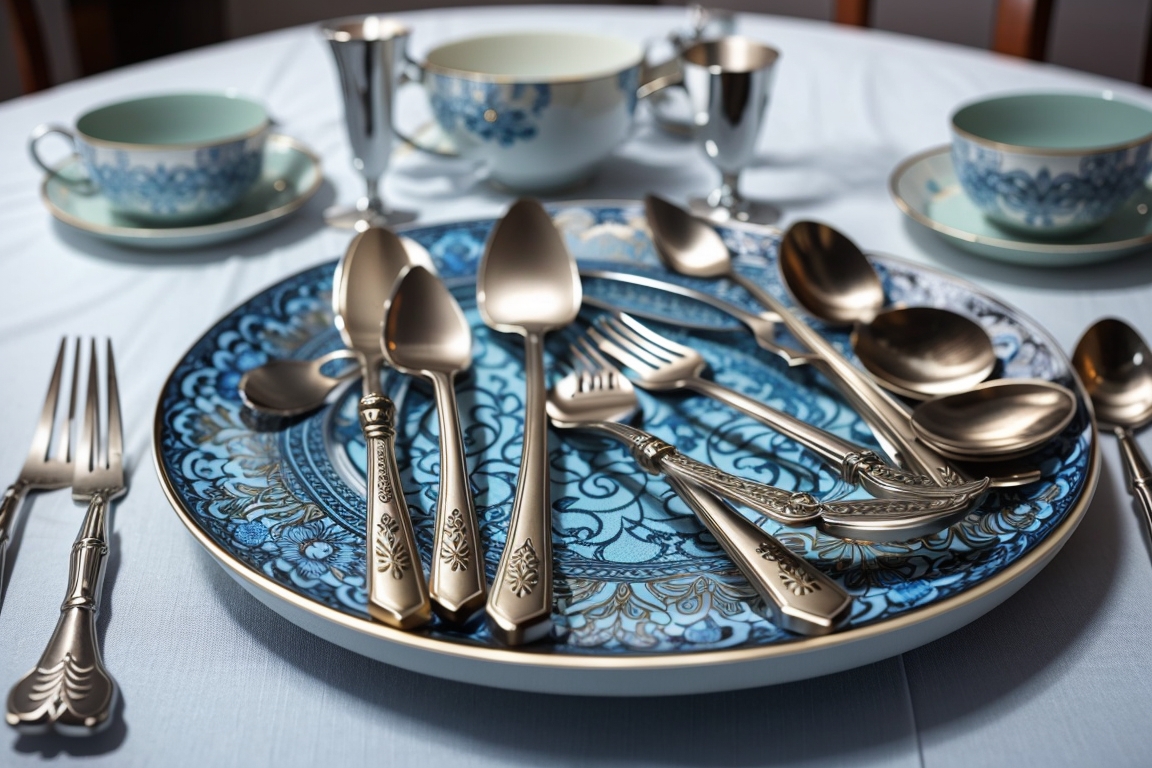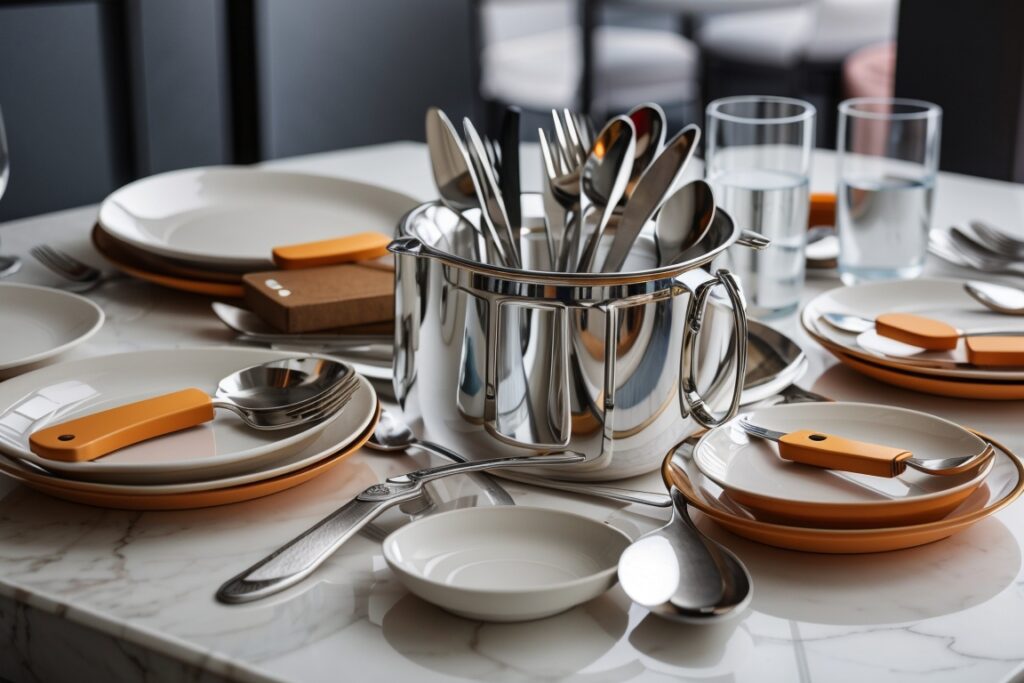In every kitchen, cutlery is like the silent conductor of a culinary orchestra, enabling us to craft and savor our favorite dishes. Yet, in a market teeming with choices, selecting the perfect cutlery set can often feel like a quest shrouded in mystery.Do not be alarmed; we are about to set off on a voyage that will reveal the mysteries of cutlery choice. This will help you navigate the subtleties by providing information on different types of cutlery, materials, upkeep, and customisation.. Prepare to discover the perfect cutlery set tailored to your unique needs and preferences.
History
The rich tapestry of cutlery sets’ history is a captivating odyssey that spans centuries and mirrors the evolution of dining customs, artistry, and societal shifts. These indispensable tableware ensembles, commonly comprising knives, forks, and spoons, have played a pivotal role in shaping human culture and culinary traditions. Let’s embark on a concise journey through the captivating annals of cutlery sets:
Ancient Beginnings:
The practice of employing utensils for dining traces its roots back millennia. In ancient civilizations such as Egypt, Mesopotamia, and China, our ancestors harnessed rudimentary tools, crafted from materials like bone, wood, and stone, to carve and manipulate sustenance. These early implements served utilitarian purposes and lacked the finesse of contemporary cutlery.
Roman Influence:
The grandeur of the Roman Empire left an indelible mark on the evolution of cutlery. Romans wielded a diverse array of utensils, fashioning them from materials like bronze and silver. They introduced the concept of distinct knives, forks, and spoons, as well as specialized utensils tailored to various culinary delights. This marked the nascent inception of the notion of a comprehensive cutlery set.
Medieval Europe:
The medieval period in Europe ushered in further transformations in the realm of cutlery. Knives evolved into indispensable personal possessions, often nestled in ornate sheaths, serving both culinary and self-defense purposes. Forks began to emerge, though their adoption faced initial resistance, deeming them as extravagant luxuries.
Renaissance and Elegance in Dining:
The European Renaissance, spanning from the 14th to the 17th centuries, witnessed the formalization of dining etiquette. This epoch saw the emergence of increasingly specialized implements and the advent of coordinated cutlery sets. Affluent families commissioned intricate and opulent cutlery sets, handcrafted from precious metals such as silver and gold.
The Industrial Revolution:
The 18th and 19th centuries brought about a revolutionary transformation in cutlery production during the Industrial Revolution. Mass production techniques democratized access to cutlery, making it attainable for a broader spectrum of society. Stainless steel, a 20th-century innovation, emerged as the quintessential material for cutlery due to its durability and resistance to corrosion.
Contemporary Cutlery Sets:
In the 20th century, cutlery sets found their place as ubiquitous fixtures in households, boasting standardized designs and configurations. Modern cutlery ensembles encompass a diverse array of knives (e.g., steak knives, butter knives), forks (e.g., dinner forks, salad forks), and spoons (e.g., soup spoons, dessert spoons). These utensils predominantly consist of stainless steel, catering to both everyday culinary pursuits and formal dining extravaganzas.
Presently, the market offers an eclectic range of cutlery sets, spanning various styles and materials, to cater to diverse tastes and preferences. These sets remain an indispensable facet of tableware, serving as a tangible testament to the ever-evolving culinary practices and societal norms that have shaped our history.
The Art of Choosing Cutlery Sets
Selecting the right materials for your cutlery sets is a bit like picking out the perfect paint for a masterpiece—it’s all about capturing the right look and feel. Here’s a friendly guide to help you navigate the world of cutlery materials:
Stainless Steel: The Reliable Friend
Pros: Stainless steel is like that trusty friend who’s always there for you. It’s tough, doesn’t rust, and is easy to take care of. Plus, it looks pretty sleek and goes with just about any table setting.
Cons: While it’s durable, it might not stay super sharp for as long as some other materials. Also, top-quality stainless steel sets can be a tad pricey.
Silver: Timeless Elegance
Pros: Silver cutlery sets are all about timeless elegance. They often come with intricate designs that add a touch of tradition to your dining experience. Silver even has some built-in germ-fighting powers.
Cons: Silver needs a little TLC in the form of regular polishing to keep its shine. It’s also a bit delicate, so it can scratch or dent more easily.
Gold-Plated: The Glam Option
Pros: Gold-plated cutlery is like the red carpet of dining. It’s all about luxury and opulence, perfect for those fancy occasions. Plus, gold doesn’t tarnish or corrode.
Cons: These sets are delicate darlings and usually need gentle hand washing to keep that gold shimmer. They can be quite an investment too.
Titanium: Sleek and Light
Pros: Titanium cutlery is the cool, lightweight kid on the block. It’s strong, doesn’t rust, and has a modern, sleek look. Great for outdoor dining adventures.
Cons: Titanium sets can be a bit pricier than stainless steel. They might not have that same traditional feel as silver or gold.
Wood: Warm and Inviting
Pros: Cutlery with wooden handles or accents brings a warm, rustic charm to the table. They’re comfy to hold and can fit into all kinds of table setups. Often, wooden handles are paired with stainless steel blades.
Cons: Wood needs a bit more love to prevent moisture damage and cracks. So, it’s usually best to hand wash these beauties.
Plastic or Resin: Affordable and Fun
Pros: Plastic or resin handles are like the playful sidekick of cutlery. They’re budget-friendly, come in tons of colors and patterns, and are great for everyday or outdoor dining.
Cons: While they’re easy on the wallet, plastic or resin cutlery might not have the same staying power or fancy vibes as other materials. They can wear down over time.
Bone or Ivory: Classic Charm
Pros: Cutlery with bone or ivory handles, while less common today due to ethical concerns, exude classic charm. They can be intricately carved and offer a unique touch.
Cons: The use of bone or ivory is a bit controversial these days and might not align with modern ethical and environmental standards. It’s worth exploring alternative options.
Ceramic: Artsy and Unique
Pros: Ceramic cutlery sets are like works of art for your table. They come in vibrant colors and unique designs, are lightweight, and resistant to stains and odors. Ceramic blades can be incredibly sharp.
Cons: Ceramic blades are a bit fragile and can chip or break if you’re not careful. And when they do get dull, they require a special sharpening technique.
In the end, the materials you choose for your cutlery sets should reflect your personal style, how you like to dine, and your budget. Whether you’re drawn to the timeless charm of silver, the modern allure of titanium, or the practicality of stainless steel, it’s all about finding what speaks to you and makes your dining experience a bit more special.
Nurturing Your Cutlery: Maintenance and Care
Taking care of your cutlery is like tending to an old friend—it’s an investment that can last a lifetime with a little love and attention. Here’s how you can humanize the process and keep your knives, forks, and spoons in their best possible condition:
Hand Washing: Treat your cutlery with the tenderness it deserves by hand washing them. Use a gentle dish soap and warm water to cleanse away the remnants of a delicious meal. Avoid rough scrubbers and harsh chemicals that might harm their finish.
Drying Ritual: After their bath, give your cutlery a warm embrace with a clean, soft towel. Letting them air dry alone in the dark can lead to water spots and, potentially, corrosion.
Safe Resting Place: Your cutlery needs its own cozy nook. Store them in a dedicated drawer or a wooden block with little slots for each piece. This prevents them from clinking together and getting those annoying nicks and scrapes.
The Sharpening Dance: Keep your knives twinkle-toed with regular sharpening sessions. A honing rod or sharpening stone is like a spa day for your blades. Sharp knives not only make your cooking easier but also feel safer in your hand.
Gentle Cutting Moves: Whisper sweet words to your knives by not chopping on unforgiving surfaces like granite or glass. Instead, use a soft cutting board made of wood or plastic. It’s like giving your cutlery a cushion to land on.
No Prolonged Baths: Your cutlery isn’t a fan of long baths. Soaking them for too long or in acidic substances can make them grumpy. If food residue is playing hard to get, a quick soak and a gentle scrub should do the trick.
Shine On: If your cutlery loses its sparkle, show them some love with a special metal polish made just for cutlery. Follow the instructions carefully to give them that radiant glow.
Save the Fancy Moves: If you’ve got some fancy, decorative cutlery, don’t overwork them. Save them for special occasions to keep them looking their best. After all, even cutlery deserves a night out once in a while.
Handle Check-Up: Occasionally, give your cutlery handles a gentle squeeze. If any of them feel loose, tighten them up or consider a professional check-up to ensure safety.
The Right Tool for the Job: Respect your cutlery by using them for their intended purpose. Avoid using knives as can openers or for prying, as this can damage the blade and make them grumble.
Expert Care: For those cherished or antique cutlery pieces, consider entrusting them to the care of professionals. These experts can work their magic to restore and protect your prized possessions.
So, remember, by pampering your cutlery, you’re not just keeping your kitchen tools in great shape; you’re nurturing a connection that can last a lifetime. It’s a touch of humanity in your daily routine that can make every meal a little more special.
The Personal Touch: Customizing Your Cutlery
Engraving and Monogramming: A Mark of Ownership
Inject a personal touch into your cutlery set by considering engraving. Your initials or a heartfelt message can transform your cutlery into a cherished heirloom.
Harmony on the Table: Coordinating with Tableware
Make sure your cutlery matches the style and color of your tableware to create a pleasant eating experience. It involves creating a welcoming atmosphere.
Conclusion: Your Culinary Adventure Awaits
Choosing the ideal cutlery set is more than just going shopping; it’s an investigation of your culinary character. The proper silverware may improve your eating experience whether you’re a seasoned chef or a casual diner.
With the ability to select the right cutlery set at your disposal, you can now start out on your mission with confidence and enjoy every culinary experience.
FAQs: Unveiling your Cutlery Set
How can I judge the quality of stainless steel cutlery?
Stainless steel cutlery quality is often determined by its composition. Look for sets with higher levels of chromium and nickel for superior durability and rust resistance.
Can I use silver cutlery for everyday dining?
While silver cutlery is undoubtedly elegant, it may require regular polishing to maintain its luster. Many reserve it for special occasions to keep it gleaming.
Are wooden cutlery sets durable?
Wooden cutlery sets can indeed be durable if you care for them properly. Avoid prolonged exposure to water and ensure thorough drying after washing.
What’s the best way to store cutlery to prevent tarnishing?
To thwart tarnishing, keep your cutlery in a dry, cool place. Explore tarnish-resistant storage solutions like anti-tarnish cloth rolls for added protection.
Can I mix and match different cutlery styles?
Certainly! Mixing and matching cutlery styles can lend a unique, personalized touch to your table setting. Just ensure they harmonize both aesthetically and functionally.








